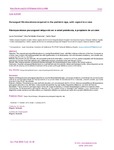Fibroqueratoma periungueal adquirido en la edad pediátrica, a propósito de un caso

View/
Use this link to cite
http://hdl.handle.net/2183/23181Collections
Metadata
Show full item recordTitle
Fibroqueratoma periungueal adquirido en la edad pediátrica, a propósito de un casoAlternative Title(s)
Periungual fibrokeratoma acquired in the pediatric age, with regard to a caseDate
2019Citation
Corominas, L., Fernández-Ansorena, A., & Saus, C. (2019). Fibroqueratoma periungueal adquirido en la edad pediátrica, a propósito de un caso. European Journal of Podiatry / Revista Europea De Podología, 5(1), 31-38. https://doi.org/10.17979/ejpod.2019.5.1.4586
Abstract
[Resumen] Objetivo: El fibroqueratoma periungueal adquirido es un tumor fibroepitelial benigno, con escasa incidencia a nivel del pie. Es una tumoración cubierta de piel hiperpigmentada con hiperqueratosis en su porción distal, de consistencia firme e indurada, y tamaño variable, que oscila entre los 3 y los 15 mm. de diámetro.
Material y métódos: Presentamos un varón de 6 años de edad, con una tumoración de 0,4 x 0,5 cm, dolorosa compatible con fibroqueratoma periungueal adquirido a nivel del hallux. Dada la edad del paciente, hay que realizar diagnóstico diferencial con tumor de Köenen.
Resultados: Tras la resección quirúrgica según técnica de colgajo en bandera, el estudio histopatológico confirma la sospecha clínica.
Conclusiones: El fibroqueratoma periungueal adquirido, es una entidad clínica e histológica bien definida y muy característica, cuyo diagnóstico puede realizarse con toda certeza y su tratamiento definitivo se realizará por medio de la escisión definitiva de la lesión. [Abstract] Objective: The acquired periungual fibrokeratoma is a benign fibroepithelial tumor, with little incidence at the level of the foot. It presents as
a fleshy mass covered with hyperpigmented skin with hyperkeratosis in its distal portion, firm and indurated consistency, and variable size,
ranging from 3 to 15 mm. diameter.
Methods: We present a 6-year-old male, who presented at the level of the hallux, a tumor 0.4 x 0.5 cm, painful compatible with fibrokeratoma
periungueal acquired. Given the patient's age, a differential diagnosis should be made with Köenen's tumor.
Results: After surgical resection according to flag flap technique, the histopathological study confirms the clinical suspicion.
Conclusion: Acquired periungueal fibrokeratoma is a well-defined and characteristic clinical and histological entity, whose diagnosis can be
made with all certainty and its definitive treatment will be carried out through definitive excision of the lesion.
Keywords
Tumor fibroso benigno
Fibroqueratoma periungueal adquirido
Uña
Benign fibroepithelial tumor
Acquired periungual fibrokeratoma
Nail
Fibroqueratoma periungueal adquirido
Uña
Benign fibroepithelial tumor
Acquired periungual fibrokeratoma
Nail
Editor version
ISSN
2445-1835





